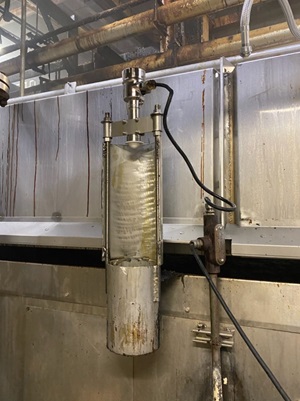Level measurements in the deep fryer without the mess
Whether it’s potato chips, fries, tater tots, or some other delicious deep-fried snack, they all require a fryer filled with oil.
Maintaining the right amount of oil in the fryer is a vital part of safe and efficient operation. Too much oil can lead to dangerous spills, costly cleanup, and product loss. Too little oil can lead to overheating and dangerous situations. Both scenarios result in lost production due to downtime. Operators ensure safe operation using level measurement instrumentation.
Making the switch to a non-contact measurement
In large fryers at food processing plants, level measurements are typically made in a small chamber off to the side using a level measurement sensor. More often than not, the technology used to make that measurement is a contact measurement using a capacitance probe or guided wave radar.
Contact measurements eventually begin to show measurement errors because of the medium they’re touching – in this case, fryer oil. As fryer oil gets dirty, its properties change and capacitance probes will output a full measurement when, in reality, the oil level is low. Guided wave radars eventually become coated with fryer oil and begin to output measurement errors, too.
A potato processing facility in eastern Oregon had been using guided wave radars for this measurement. Operators had to clean the sensor probe on a regular basis to receive accurate measurements. It was a labor-intensive task with multiple fryers to maintain.
Operators wanted a more reliable measurement without the need to constantly clean and maintain their guided wave radar. However, they needed a solution that could make a measurement inside the small chamber connected to the fryer, which was less than a foot in diameter.
80 GHz frequency for measurements in tight spaces
The VEGAPULS 64 is a non-contact radar sensor for liquids level measurement. This tank level sensor transmits its signal using an 80 GHz frequency, which gives it exceptional focusing – a beam angle as narrow as 3° with some process connections. The more focused radar beam ensures most, or all the radar signal meets the product surface and returns a stronger signal.

Making the switch to a new measurement principle
The Oregonian potato processing facility learned about the VEGAPULS 64 from their VEGA sales advisor, and opted to give the new technology a try. Operators configured their radar sensor with a stainless steel housing and hygienic fittings for easy cleaning. Plus, the radar was robust enough to withstand the heat from the hot vegetable oil.
After a few weeks in use, VEGA checked with facility operators to find out how the new technology had been working. Operators haven’t needed to clean the sensor antenna, and their process has been running longer because of minimal downtime related to regular upkeep.
The VEGAPULS 64 radar level sensor’s non-contact measuring principle paired with its 80 GHz technology made it the ideal solution for this application, and the customer placed an order for two more radar sensors for the same application within the facility.Related products
Export this article
Download as PDFShare this article
Comments ({{comments.length}})
{{getCommentAuthor(comment, "Anonymous")}} {{comment.timestamp | date : "dd.MM.yyyy HH:mm" }}
{{comment.comment}}





